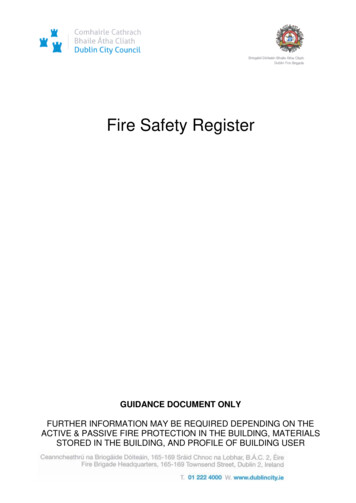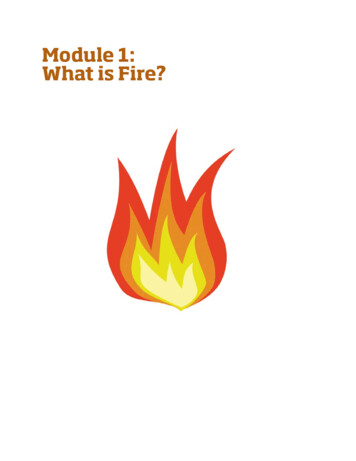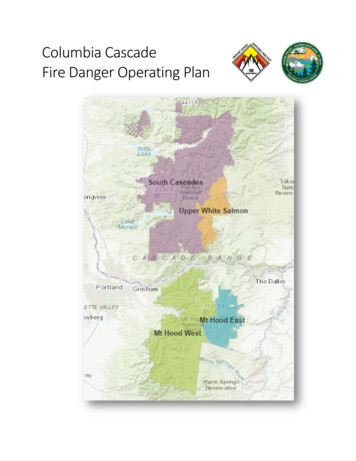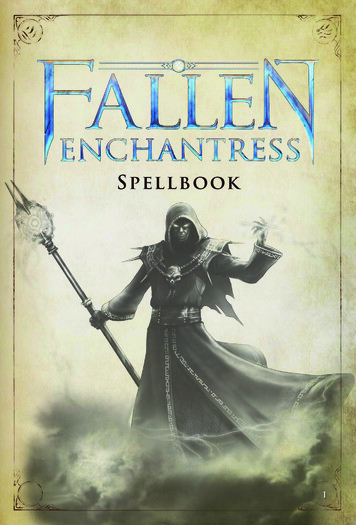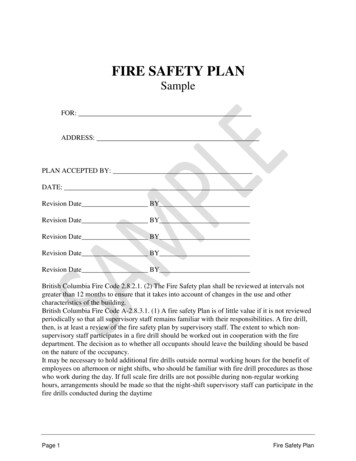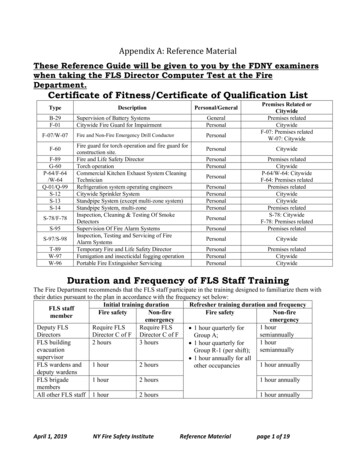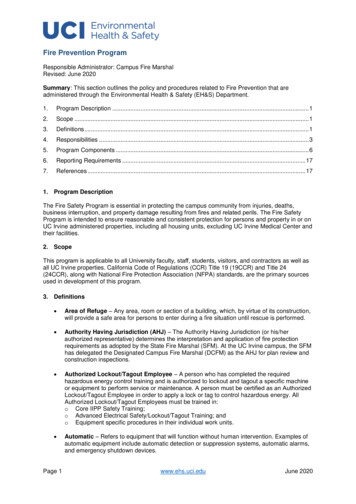
Transcription
PRESENTED TO THE HOUSE OF REPRESENTATIVES PURSUANT TO SECTION 150(3) OF THE CROWN ENTITIES ACT 2004.Annual ReportFor the year ended 30 June 2017ISSN 2324-5646 (PRINT)G8
ANNUAL REPORT FOR THE YEAR ENDED 30 JUNE 2017Our year at a glanceAs at 30 June 2017OUR PEOPLE1,7348,1613,134672CAREER FIREFIGHTERSURBAN VOLUNTEERSRURAL VOLUNTEERSMANAGEMENT ANDSUPPORT STAFF1 JULY 2016 – 30 JUNE 201777,465EXPENDITUREINCIDENTSATTENDEDCAPITAL 48.5 MILLIONAn increase of 3.5% on 2015/16 (one in every three were false alarms)This included:OPERATING 423.6 MILLIONIncrease/decrease2,2605,236EXTREME WEATHER EVENTSSTRUCTURE FIRES11,6816,217MEDICAL EMERGENCIESMOTOR VEHICLE ACCIDENTS3,8593,280VEGETATION FIRESHAZARDOUS MATERIALSASSET BASEREVENUE 776.4 MILLION 417.7 MILLIONMOST TRUSTEDPUBLIC SECTORORGANISATION1OUR NETWORK – FIVE REGIONSFIRE STATIONS BY REGIONRegion 1 Region 2 Region 3 12219%17%24%Region 4 22%Region 5 18%FIRE STATIONS BY TYPEVolunteer stations 360Career stations 46Colmar Brunton’s 2017 Public Sector Reputation Rankings.Volunteer and career.Composite2 stations 33Rural fire forces 196Volunteer 82%Career 10%Composite 8%
NEW ZEALAND FIRE SERVICE COMMISSIONContentsNew Zealand Fire Service Commission 4Our history through the decades 5The Board 8Chair’s foreword 10Chief Executive’s overview 11Our priorities 13Transition to Fire and Emergency New Zealand 15Safety of New Zealanders 19Safety, health and wellbeing of our people 25People capability 29Volunteer and brigade resilience 37Incident management 41National Rural Fire Authority 47Capital investment 53Statement of Performance 57Statement of Responsibility 72Independent Auditor’s Report 73Fire Service Levy 76Financial Commentary 77Statement of Comprehensive Revenue and Expense 82Statement of Financial Position 83Statement of Changes in Equity 84Statement of Cash Flows 85Notes to the Financial Statements 86Glossary 1243
ANNUAL REPORT FOR THE YEAR ENDED 30 JUNE 2017New Zealand FireService CommissionOur VisionTe Manatū o ngā ratonga ohotata kia haumaru ake ai a Aotearoa.Leading integrated fire and emergency services for a safer New Zealand.Our mission To reduce the incidence andconsequences of fire, and toprovide a professional responseto other emergencies.Our goalsOur values To protect people, property and theenvironment by providing a promptand efficient response to fires andother emergencies. Service. To promote fire safe behaviourand practice through proactivepublic education and rural firecoordination. Skill. Integrity. Adaptability. Comradeship. To make communities resilientby preparing for and respondingto a broad range of non-fireemergencies in collaboration withother agencies.Our roleThe New Zealand Fire Service Commission wasestablished as a Crown entity under section 4of the Fire Service Act 1975. The Crown EntitiesAct 2004 prescribes the accountabilityframework for the Commission, and sets outthe relationships among the Minister, the Chair,the Board and the Chief Executive, and betweenthe Minister and Parliament. The New ZealandFire Service Commission has five principal roles:4 Governance and operation of the New Zealand Fire Service. Exercising the functions of the National Rural FireAuthority (NRFA). Coordination of fire safety throughout New Zealand. Receipt and audit of the proceeds of the Fire Service Levy. Preparation for Fire and Emergency New Zealand.
Our historythrough the decadesAs we approach a new beginning, we take a look back at our historyand reflect on the events that have shaped where we are today.
“First NZ volunteerfire brigade formsin Auckland.”Back in ye olde days,insurance companiessponsored a few firebrigades to fight firesBUT only at insuredbuildings that werespecially marked. Tocombat the blaze,brigades used waterbuckets but, thankfully,soon upgraded tomanual pumps providedby the Auckland CityCouncil and ofcourse the insurancecompanies.Volunteer firebrigade formsin Dunedin.New Zealand’s firstpaid firefighter ationAct 1867.Lyttelton’sbusinesscentre burnswhile residentsdemolishbuildings tostop flamesspreading. Theyhad no brigadeat the time.1870s1854187918611858Auckland firedestroys much of thecommercial district aroundHigh and Shortland Streets.1868The firstpermanentlymanned brigadeis establishedin Christchurchallowing paidfirefighters tolive there.Fire inDunedin’sOctagonengulfs manybuildingskilling 12 people.1880s“Water, water(buckets)everywhere.”It wouldn’t havelooked strangewhen walking intosomeone’s hometo find two bucketsof water by thedoor. Set by theWellington ProvincialCouncil, the TownProtection Actrequires all citizensto keep pails ofwater at the ready tohelp put out fires.1860s1850s18561878United Fire Brigades ofNew Zealand founded.“Jump for your life.”Dunedin Brigade importsthe first 15-metre telescopicfire escape ladder. Aroundthis time, the first use of‘jumping sheets’ is recorded.Jumping sheets are used tocatch people leaping fromburning buildings andprobably in a single boundas well.
1900sThree seriouscentral Aucklandcity firesincluding a blaze in theGrand Hotel take fivelives, leading to therestructuring of theAuckland Fire Brigade.1888Let there be light.Twelve automaticelectric street alarmsare installed inAuckland, replacingalarm bells andlookout towers.19071903“The first motorised fireengine in Australasia.”Of all places to have it first,Whanganui receives the‘Merryweather AutomobileSteam Fire Engine’, the firstin Australasia, becomingthe pride of the WhanganuiFire Brigade. There is anunveiling, in which the mayoraddresses the large crowdsat the Fountain, while “LadyMayoress” starts pumping theapparatus. After three loudcheers, the lever is pulled anda jet of water shoots over thePost Office tower. An eveningdemonstration also takesplace and at the conclusion,the Garrison Band plays theBrigade home.“Burning downthe House.”11 December. The firstParliament buildings inWellington, which weremade from wood, aredestroyed by fire. Manyonlookers and firemenrace to save books, papersand artworks, while theGeneral Assembly Librarynext to it is saved due toits fire walls and metal firedoor. Parliament sits inGovernment House until thereplacement, wisely built ofstone, is erected in 1918.1920s1901Fire BrigadesAct signed intoexistence.Auckland andWellington also takepossession of these‘self-propelled’motorised firemachines.1910s1906“SMASH IT.”A Dunedin City Brigade memberinvents a new system ofstreet alarms. If there’s a fire,a member of the public willsmash a glass box situated ona lamp post. This sends a signalto a switchboard operator whothen sends a fire engine tothe address indicated by thesignal’s location. Believe it ornot – this is to be the mainsystem in New Zealand for thenext 50 years and is still beingused in some towns up until thelate 1970s.1930s19131930Founded:New ZealandFire BrigadesInstitute.1926The UpdatedFire BrigadesAct 1926.
1949Fire Services Act.First standardisation attemptof the Fire Service organisation,administration and financing.1940sAll hands on deckWith many men away serving overseas in thearmy in World War II, women step in to manynon-traditional roles to support the war effort.Women are trained to carry out fire-fightingduties all over New Zealand. Almost withoutexception, these women are from variousdivisions of the Women’s Auxiliary servicessuch as WWSA (Women’s War Service Auxiliary)and WAAC (Women’s Auxiliary Army Corps).1940sUnder the WWSA, women volunteer for firewarden duties in Christchurch, staff Wellingtonfire station and work out of Auckland firestation, attending fires, running out hose,driving appliances to fire calls, testingextinguishers and fire alarms, and checking onfire wardens in the city.Fire Service Regulation,Code of Practice andCoordination Schemeis put in place to allow extendedcooperation between brigades.1960s1950s1954194719428 December. Fire atSeacliff Mental Hospital.Thirty-seven patients, whowere locked in an unsupervisedward, die, resulting in arecommendation that automaticfire detection systems andsprinklers be installed inpsychiatric hospitals.“Ballantynes Fire.”Seventy years ago, during Cup week in Christchurch,Ballantynes is inundated with an estimated 250–300visitors and shoppers, along with a staff of 458. Midafternoon on 18 November, a fire starts in one thebuilding’s basements. By 3.35 pm, a staff member seessmoke emerging from the stairwell and asks anotherstaff member to alert the brigade. At 3.48 pm, thefire is swelling out of control and the brigade arrivesundermanned and unable to handle the extent of theinferno. In the end, the fire claims 41 people, the mostvictims to date in New Zealand fire disaster history.A Royal Commission of Inquiry finds that Ballantynesand the fire brigade did not reasonably provide safetyand escape measures for staff and public. Upon theInquiry’s recommendations, the Fire Services Act 1949is introduced, attempting to standardise the FireService organisation, its administration and financing.The Act also establishes the Fire Service Council, whichrepresents the Government, insurance companies, localauthorities, and the United Fire Brigades’ Associationand the firefighters.1957Fire Service TrainingSchool to open inIsland Bay, Wellington.
19841 9791974–1975Creation of theNew ZealandFire ServiceCommission.Landmark genderequity battle begins.Fire communications centreworker, Anne Barry appliesto join the Fire Service as acareer firefighter.Anne is initially rejectedfor not meeting the heightrequirements but it soonbecomes apparent that thereal reason for rejection isbecause she is female. Annetakes the New Zealand FireService Commission to theHuman Rights Commission inorder to have the opportunityto train as a career firefighter.19761 April. Who yougonna call?The New Zealand FireService goes live today.1973“What’s that smell?”February. In Parnell, Auckland, leakingchemical drums are dumped causing anemergency resulting in 6,000 people beingevacuated from their homes. 643 people aretreated in hospital, including 41 firefightersinjured from either inhaling fumes orreceiving burns from the caustic soda used toneutralise the spilled chemical.1970First ‘snorkel’applianceis deployed toWellington. Nowknown as ‘Type5’ appliance.1980s1970sJuly. Fire at Sprott House, anursing home in Wellington.Seven elderly women residentsdie. Leads to the Fire Safety(Evacuation of Buildings)Regulations 1970 makingsprinklers, automatic alarms andevacuation schemes compulsoryfor institutions housing morethan 20 people.A fire breaks outin Auckland’sICI’s chemicalwarehouse.Sixty firefighters areinjured after theycome into contactwith chemicals. Theinvestigation into thefire results in improvedclothing for firefighters,a standard procedurefor fireground safety,the introduction offireground safetyofficers and changesto the occupationalhealth service.19951990s1969A majorrestructureoccurschangingfrom sixregions and 20areas to threeregions and 11areas. Legalaction is taken.19901981Fire Incident ReportingSystem begins.Pre-cursor to IntergraphComputer Aided Dispatch(ICAD) reporting system.SuccessOn 27 July, Anne Barrywins her two-year battle withthe New Zealand Fire ServiceCommission and is allowed toapply to join the Fire Serviceas a career firefighter.Proving themselvesOn 4 November, ElizabethEngland and Anne Barrycomplete the Fire Service’srecruit course, with overallplacings of second and thirdrespectively, becomingNew Zealand’s first femalecareer firefighters, and thefirst female career firefightersin Australasia.Fire ServiceAmendment Actchanges the make-upof the New Zealand FireService Commission.1989Fire at Auckland’sTerwindle Rest Homecauses the death ofsix elderly residents.Further fire deaths in resthomes in Feilding andCollingwood in the 1990slead to the Fire Servicecalling for compulsorysmoke detectors andsprinklers.
201119981997Fire Service isrestructuredinto eight fireregions witha corporateoffice and aNational ServiceCentre. Knownas the “FutureDirection”project.2000sPart of thatrestructuresets out torearrangefirefighternumbers andemploymentconditions,which leads toindustrial unrest.22 February. Christchurchearthquake, 185 deaths.2006National TrainingCentre opensin Rotorua.201614 November.Kaikouraearthquake,magnitude 7.8,two deaths.‘Speed of Fire’advertisementis launchedshowing peoplehow quickly firespreads. Thesuccess of theadvertisement isstill felt today.2001Fire Service launchesFirewise, the flagship fireeducation programme.Stronger togetherIn May, a group of career femalefirefighters meet in Auckland todiscuss the possibility of settingup a support network group.Many topics are discussed overthe two days of the meeting, andone outcome is the formationof New Zealand Fire ServiceWomen (NZFSW).1999The Audit Office criticisesthe disagreements betweenthe New Zealand Fire ServiceCommission and the ChiefExecutive on a proposedagreement with the New ZealandProfessional Firefighters Union.2010s20032010201719 November.Pike RiverMine disaster,29 deaths.ChristchurchPort Hills fires.Starts 13 February 2017.Steve Askin, helicopterpilot and sole occupant,crashes and dies.2008Fire Servicejoins the 50-yearcelebrationof the 111 emergencyphone number.2015New Zealand FireService Women(NZFSW) is rebrandedas Women in Fireand Emergency NewZealand (WFENZ).
ANNUAL REPORT FOR THE YEAR ENDED 30 JUNE 2017The BoardMembers of the New Zealand Fire Service Commission Board are appointed by theMinister of Internal Affairs having regard to criteria set out in both the Crown EntitiesAct 2004 (as amended in 2013) and the Fire Service Act 1975.The Board members are:Hon. Paul Swain, QSO (Chair)Paul was appointed as the Board’s Chair in April 2016 after leading the independentreview of the Fire Service in 2012, which resulted in a call for reform.His political career has spanned some 18 years, during which time he has held anumber of ministerial portfolios, including state-owned enterprises, corrections andimmigration. He was also a negotiator in Waitangi settlements, and holds a seat onthe Wellington Regional Council.Paul was made a Companion of the Queen’s Service Order in 2009.Organisational committees: Chair – Rural Fire Committee. Member – Remuneration Committee. Member – Audit and Risk Committee.Declaration of interests: Greater Wellington RegionalCouncillor. Chair – New Zealand UtilitiesAdvisory Group. Principal – Paul Swain Consulting. Former Chair – Fire Review Panel(2012).Dr Nicola Crauford (Deputy Chair)Nicola was appointed as the Board’s Deputy Chair in April 2016. She has a wealth ofgovernance experience, including a sound understanding of rural fire that was gainedduring her time as Chair of the Wellington Rural Fire Authority.Organisational committees: Chair – Transition Committee.Member – Remuneration Committee.Declaration of interests: Director – Watercare ServicesLimited.Advisor – Wellington Water Limited. Director – Orion New Zealand. Chair – GNS Science. Director – EnvironmentalProtection Agency.8 Advisor – WorleyParsonsNew Zealand Limited. Member – Electoral Authority of theCo‑operation Bank Limited. Director and Shareholder – RiposteConsulting Limited.
NEW ZEALAND FIRE SERVICE COMMISSIONTe Arohanui CookFirst appointed to the Board in April 2016, Te Arohanui has had significant engagement withrural fire at both an operational level and through her involvement in rural fire training.Organisational committees: Member – Audit and Risk Committee.Declaration of interests: Volunteer Firefighter – Waipukurau. Former Director and Shareholder –RFNS Training Services Limited. Former Principal Rural Fire Officer –Central Hawke’s Bay. Director and Shareholder – PhoenixVentures Waipukurau Limited.Peter Drummond MNZMPeter was appointed to the Board in April 2016, and has an extensive background in governanceand leadership roles. As a former Chair of the United Fire Brigades Association, Peter has anin-depth understanding of volunteers and the role they play in fire and emergency services.Organisational committees: Member – Transition Committee.Declaration of interests: Chairman – Appliance Connexion GroupServices Limited. Director – NARTA New Zealand Limited. Director – Score Limited. Director – NARTA International PtyLimited. Chairman – Medical Missions SouthPacific. Chairman – Watercare Harbour Clean‑UpTrust. Director – Port MarlboroughNew Zealand Limited. Chairman – Whip Around. Director – Ngāti Awa. Former Member – Fire Review Panel(2012).Angela Hauk‑WillisAngela has a wide range of governance experience, including being a Board memberwith the New Zealand Fire Service Commission since 2011. Angela brings continuity ofgovernance to the Board as it leads the establishment of a new organisation.Organisational committees:Chair – Audit and Risk Committee.Chair – Remuneration Committee.Deputy Chair – Transition Committee.Declaration of interests: Trustee – 2020 Trust. Principal – Angela Hauk‑Willis Consulting. Chair – Risk and Assurance Committee,Ministry of Transport.9
ANNUAL REPORT FOR THE YEAR ENDED 30 JUNE 2017Chair’s forewordI’m pleased to present the final Annual Report of theNew Zealand Fire Service Commission, which will becomethe Fire and Emergency New Zealand Board as of 1 July 2017.The past 12 months have seena remarkable amount of changefor the fire services sector, asthe New Zealand Fire Service,the National Rural Fire Authority,12 enlarged rural fire districtsand 26 territorial authority RuralFire Authorities prepared toamalgamate into one organisation.The Board would like to acknowledgeHon. Peter Dunne, Minister ofInternal Affairs, for his leadershipin the sector and his integral rolein driving the Fire and EmergencyNew Zealand Act 2017 throughParliament, thereby providing thelegislative platform for our fire andemergency services to better meetthe challenges that New Zealandfaces in the 21st Century.While the promotion of fire safetyremains the first of Fire andEmergency’s main legislativefunctions, its wider emergency roleis evident in the detail of the 77,465incidents attended by firefightersthis year, with sustained increases inthe number of medical emergencies(3.0%) and motor vehicle accidents(12.7%) against the previous year.On top of these critical servicesprovided to New Zealanders ona 24/7 basis, this year has alsoseen its share of major incidents,including the Kaikoura earthquake,Port Hills fires and other majorfires, as well as significant floodingright around the country. Incidentsof this type have all demonstratedthe need for emergency servicesto work more closely together.10Given the critical nature of thiswork, the Board’s focus for ‘DayOne’ has been to ensure that theamalgamation of urban and rural fireservices occurs without disruptionto emergency response, payroll, oroperational command and control.For that reason, Fire and EmergencyNew Zealand will be establishedin three phases – amalgamation,integration, unification.Following amalgamation on1 July 2017, the existing urban andrural structures will be graduallyintegrated over the next threeyears towards full unification from2020 onwards. Success here isdependent on our ability to continueto draw on the skills, knowledgeand experience of our people.The transition to Fire and EmergencyNew Zealand has been characterisedby a ‘co‑design’ approach, with over700 events, workshops and forumsheld this year with operationalpeople, the unions and associationswho represent them, and our partnerorganisations in the sector. We havebeen very encouraged by thewillingness of these diverse partiesto actively participate in the designprocess and we look forward to thiscollaborative relationship continuingas Fire and Emergency New Zealand’sstandard way of working.In the meantime, the Board would liketo commend everyone in the urbanand rural fire services for anotheroutstanding year of hard work tokeep our communities safe. We lookforward to these strong foundationsof service continuing under Fireand Emergency New Zealand, as webuild on the positive legacy of thepast in preparation for the future.Hon. Paul SwainBoard Chair
NEW ZEALAND FIRE SERVICE COMMISSIONChief Executive’s overviewFirstly, I would like to thank all our people – urban, rural,career, volunteer, operational and non-operational alike –for all the hard work they’ve put in this year. We are gratefulfor their efforts in responding to major incidents like theKaikoura earthquake, Hawke’s Bay and Port Hills fires, andflooding in Edgecumbe and other parts of the country – ontop of all the ‘regular’ incidents we respond to on a 24/7basis. All the while they were participating in the biggestchange to New Zealand’s fire sector in a generation.The Kaikoura earthquake was aparticularly challenging event.This 7.8 magnitude earthquakeimpacted multiple locations,including Kaikoura, which wascompletely cut-off by slips. We hadsignificant damage in smallerSouth Island towns like Waiau, aswell as Wellington’s CBD, whichwas then hit by torrential rain thefollowing day, cutting off the twomajor roads in and out of the city.I’m very proud of the way all ourpeople conducted themselves, fromthe local brigades who were firston-scene, to our Urban Search andRescue (USAR) teams, the ruralfirefighters who supplied water in4WD tankers to cut-off farmers,and those who coordinated thenecessary logistics for our responseefforts. Each group brought theirown strengths to the situation, andwill be even more effective whencombined into a single, integratedfire and emergency service.Sadly, the year was not withouttragedy and our thoughts are stillwith the friends and family of pilotSteve Askin, who was killed in ahelicopter crash while responding tothe Port Hills fires. It’s an unfortunatereminder of the risk that is inherentto the incidents our people attend,which is why their safety, healthand wellbeing is paramount to us.Progress in this area includesthe completion of our line rescuetraining project, a new peersupport programme to supportpsychological wellbeing after workingaround traumatic incidents, anda project to increase the safety ofour people when working in andaround water through awareness,training and the right equipment.It has also been a more positiveyear for avoidable fire fatalityprevention, with a decrease inthe number of avoidable deathsto 14 from last year’s total of 18.That said, these figures demonstratethe continued necessity of firesafety promotion, particularly assix of these occurred in homeswith no working smoke alarms.Connecting with our communitiesis an integral part of promotingfire safety, hence the need for ourworkforce to become more inclusiveand diverse. Our people-led groupsto increase the number of women,Māori and Pacific Island peopleshave made great progress thisyear. We have a long way to go withfemale firefighters making up just3.5% of our career workforce, butwe are encouraged to see that theproportion of successful femaleapplicants has jumped from 1%to 17% over the past three years.Finally, it was pleasing to hearthat the Fire Service led ColmarBrunton’s ‘most reputable publicsector agency’ index for thesecond year running in 2016/17.This reputation comes down to theactions of our people, and I have nodoubt they will continue to build onour proud history under the bannerof Fire and Emergency New Zealand.Paul McGillChief Executive and NationalCommander11
We work closelywith otheremergencyservices toprovide thehighest levelof protection.
NEW ZEALAND FIRE SERVICE COMMISSIONOur prioritiesIn our 2014–2018 Statement of Intent, we set out a range of ambitious goals backed byan extensive programme of work to achieve our vision of “leading integrated fire andemergency services for a safer New Zealand” by 2020. Considerable progress has beenmade towards achieving that vision as we continue to focus on our people and how wedo our work to best serve our communities.Implementing the Government’sdecision to unify New Zealand’sfire services by 1 July 2017 hasbeen a major focus for us thisyear. Embedding the fundamentalprinciples and intent of Vision 2020has prepared us well for the mostimportant change in New Zealand’sfire and emergency servicesin decades – the transition toFire and Emergency New Zealand.Our priorities are: Transition to Fire and Emergency New Zealand. Safety of New Zealanders. Safety, health and wellbeing of our people. People capability. Volunteer and brigade resilience. Incident management.Whakaratonga iwi.Serving our people.13
NEW ZEALAND FIRE SERVICE COMMISSIONTransition to Fire and EmergencyNew ZealandEstablishing a unified fire service for the 21st century.One of the key priorities for the New Zealand Fire Service Board in 2016/17 was ensuringthe successful transition to Fire and Emergency New Zealand on 1 July 2017. This involvedthe amalgamation of the New Zealand Fire Service, the National Rural Fire Authority (NRFA)and 38 Rural Fire Authorities (RFAs) into a single, unified organisation. The decision for thischange in structure followed two comprehensive reviews of the fire services undertakenbetween 2012 and 2015, extensive consultation with stakeholders, and wide agreementon the type of fire and emergency services that are needed in New Zealand and how theyshould be supported and funded.Work on the transition toFire and Emergency New Zealand(the Transition) commenced in April2016 with the establishment of adedicated Transition Project team.The work of the Transition Projectwas overseen by the TransitionCommittee, a sub-committeeof the New Zealand Fire ServiceCommission Board.The Transition Project successfullyachieved its two objectives for2016/17:1. Establishment of Fire andEmergency New Zealand by1 July 2017, including all of theimmediate requirements of theFire and Emergency New ZealandAct 2017.2. Design of what Fire and EmergencyNew Zealand will look like beyond1 July 2017 and the plan to createthis vision.There was a strong emphasis onensuring that key stakeholdersand personnel were engaged inthe Transition representing all partsof the sector – urban, rural, careerand volunteer.Outputs and measures to meetthese objectives were set outin a 2016/17 Memorandum ofUnderstanding (MOU) betweenthe Minister of Internal Affairs andNew Zealand Fire Service CommissionBoard. Among the measures, 19 of21 were met by 30 June 2017,while the remaining two wereadjusted because more appropriatedeliverables were identified.Funding to support transition activitywas successfully secured in 2016/17.The Government agreed to up to 112 million over four years to allowFire and Emergency New Zealand toembed all of the requirements of theFire and Emergency New Zealand Act,creating a single, unified organisation.This funding is to be repaid over10 years. The Government alsoagreed to 191 million in new fundingover four years to, in the main,provide support for volunteers andaddress gaps in investment betweenthe urban and rural fire sectors.Throughout 2016/17, the TransitionProject worked closely with theDepartment of Internal Affairsto support the development andprogress of the Fire and EmergencyNew Zealand Bill. The Fire andEmergency New Zealand Act 2017received Royal Assent on 11 May2017 and provided the mandate forestablishing the new organisationand the functions it will deliver.Over the past 12 months, asignificant amount of work andactivity to support the Transitionhas been delivered given thescale and complexity of this work.This positioned the project well toensure the successful transition toFire and Emergency New Zealandand to lay the foundations for itseffective operation from 1 July 2017.15
ANNUAL REPORT FOR THE YEAR ENDED 30 JUNE 2017Day One of Fire andEmergency New ZealandThe focus for Day One ofFire and Emergency New Zealandwas on ensuring: the safety, health and wellbeingof our people the ability to respond on Day One Fire and Emergency New Zealandpersonnel knowing who theyreport to Fire and Emergency New Zealandpersonnel being paid the reputation of the fire servicesbeing maintained.To successfully deliver on these,transition work was guided by aDay One Blueprint, which provideda high-level description of what theBoard intended the new organisationto look like on 1 July 2017 and thefocus for Day One. It specified thatthe change for Day One neededto be realistic and pragmatic,and that transition to the neworganisation should be underpinnedby extensive communications andstakeholder engagement, bothinternally and externally.The Transition Project reached30 June 2017 on track and budget,with no significant risks or issuesfor Day One. In line with the DayOne Blueprint, key achievements in2016/17 to support the Transition on1 July 2017 included the legal transferof personnel to Fire and EmergencyNew Zealand, developing the identityand brand for the new organisation,establishing an agreed policy andapproach for how command andcontrol response will work from DayOne, authorising approximately13,000 operational personnel to carryout the necessary functions requiredfor their role from 1 July 2017, anddetermining the formal arrangementsthat need to be in place across thesector to ensure fire and emergencyservices are maintained.16Leading our people throughchange and working withthe sectorA significant focus in the period upto the establishment of the neworganisation was leading peopleeffectively through the Transition,and ensuring personnel were awareof the proposed changes and whatthey meant for them. Critical tothis was ensuring that leaderswere appropriately equipped andempowered to provide their peoplewith information on the Transition,had plans in place to lead themthrough the change and to supportthe creation of the new organisation,and had the necessary supportand authority to take on their ownnew responsibilities.Specific activity to support thisincluded: dedicated Leading through Changeforums in Auckland and Wellingtonin February and March over 200 leader-led discussionsacross the country to briefleaders and the workforce
Octagon engulfs many . buildings killing 12 people. 1868. The first permanently . manned brigade is established . in Christchurch allowing paid firefighters to live there. . insurance companies, local authorities, and the United Fire Brigades' Association and the firefighters. 1940. s All hands on deck.


